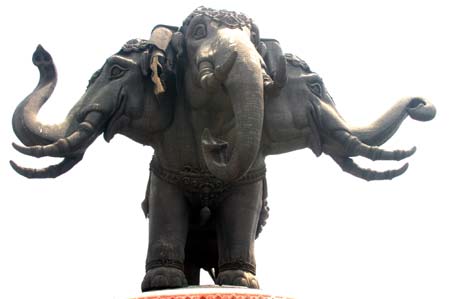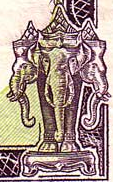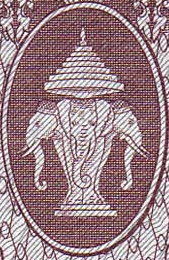 Paper Money Collection
Paper Money Collection Paper Money Collection
Paper Money Collection
| [ Last Update: Sunday, 29-Nov-2009 10:51:02 EST ] |
 Erawan Museum in Samut Prakan, Thailand |
Erawan is the Thai name for Airavata, the mythological elephant from Hindu mythology. Erawan is known as Airavata or Airawana in Sanskrit, as Erawana in Bali and as Airapot, Airawat or Erawan in Thai. All of these names refer to the action of rain clouds and lightning that results in rain, sent down by the god Indra as he rides the elephant god Erawan across the heavens.
According to Aryan legends, the god Erawan is huge, white and has 33 heads. Each head bears seven tusks. For each tusk there are seven lotus ponds. Each pond has seven lotus pads, each pad has seven lotus blossoms and each blossom has seven petals. On each petal dance seven angels. Each angel has seven ladies-in-waiting. So altogether the god Erawan has 33 heads, 231 tusks, 1,617 ponds, 11,319 lotus pads, 79,23 lotus blossoms, 554,631 lotus petals, 3,882,417 angels, and 27,176,919 ladies-in-waiting.
The main duty of Erawan the elephant god is to serve as Indra's mount in his travels to different locations in the heavens and on earth, where he observes the varying fortunes for mankind. Erawan is, in particular, associated with the east and the sun's care for that part of the world. Erawan also serves as Indra's war elephant in his battles with the demons. Indra, being the chief of the gods and responsible for the world's weather, uses the lightning bolt as his weapon to fight drought and bring the blessings of rainfall to the world of men. Erawan is thus assigned the task of drawing up moisture from the earth to the sky, whence Indra returns it to the earth in the form of rain. The people of South and Southeast Asia have long had a special regard for the god Erawan due to this life-giving benevolence.
As the beloved companion of Indra, the god Erawan is considered to be the lord of all elephants in the universe. He is, moreover, taken to be a symbol of Indre himself, of virtuous action, and of prosperity. For artistic reasons, he is usually portrayed with only three heads, rather than 33 heads in the myth.
One of the legends concerning Erawan holds that Lord Shiva gave him as a gift to Indra, and that Erawan was originally a god stationed in the Dao-wa-Deaung heaven. Wherever Indra went, Erawan would follow in the guise of a white elephant. Another story is that Makamanop employed this elephant in building a pavilion on earth. When the elephant died, it was reborn as a god in the shape of an elephant, and then taken by Indra to serve as his mount.
Not only is Erawan, the lord of all elephants and the most powerful, he is said to be as large as a mountain of Indian mythology. So brilliantly white is Erawan that he makes Mount Kailasa, made entirely of silver, lood dark by comparison. In the Mahabharata, it is said that "The god Airavata has four tusks and three trunks. He is great in size, and pearly white."
Examples of Erawan on Banknotes
 Erawan depicted on a Thailand P75d ND (1953-1956) Issue 5 Baht Note |  Erawan depicted on a Lao P8 ND (1962) Issue 1 Kip Note |